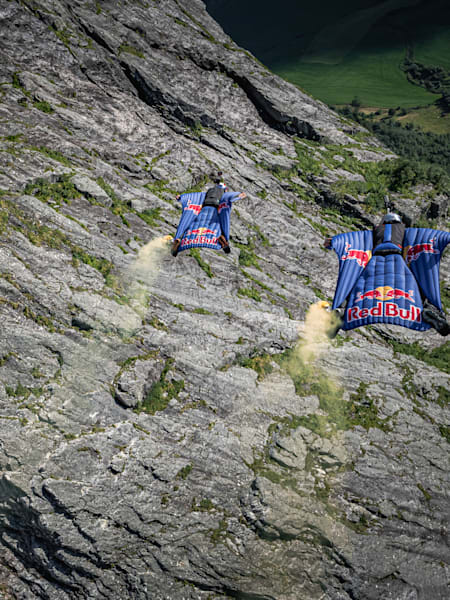From Icarus in Greek mythology to Leonardo da Vinci's machines – the idea of flying like a bird has always dominated humankind's wildest dreams. Today, thanks to the wingsuit, this dream has become a reality.
In recent years, wingsuit flying – or wingsuiting – has become one of the most popular and thrilling disciplines in the world of extreme sports.
The sport requires perfect body control and balance. Once it’s mastered, it offers the ultimate adrenaline rush: to soar through the sky like a bird at speeds of over 155mph (250kph).
But how did wingsuits come about, how are they used, and most importantly, how do they work? Scroll down for the answers.
01
What is Wingsuit Flying?
Wingsuiting is the world's most extreme air sport, so it’s not something that you can just ‘have a go’ at. ‘New’ pilots are hugely experienced skydivers who will have 200-500 jumps under their belts before they even think about putting on a wingsuit.
02
The History of the Wingsuit
The first recorded attempt at wingsuit flying took place in Paris in 1912. This was when Franz Reichelt, an Austrian-born tailor, jumped from the first floor of the Eiffel Tower using a parachute-like suit of his own design. It failed, with tragic results, and Reichelt fell 187ft to his death.
However, this disaster did not deter others in the decades that followed, with many different homespun designs emerging.
By the 1930s, Americans Rex G Finney and Clem Sohn (known as ‘The Bird Man’) had successfully developed wingsuits made of canvas or sailcloth. By the 1950s, the Frenchman Leo Valentin had gone further, adding a pair of fixed wooden wings.
Though the suits were proven to work, they all had one thing in common: they were extremely dangerous. Though they gained fame from their exploits, Finney, Sohn and Valentin all died while wingsuit flying.
In 1994, French skydiver Patrick de Gayardon developed a new, more reliable wingsuit design with webbing under the arms and between the legs. This new ‘ram-air wingsuit’, based on earlier creations by the American John Carta, enabled much more controlled horizontal flight.
In 1999, Finn Jari Kuosma and Croatian designer Robert Pečnik released the first mass-produced wingsuit. Using de Gayardon’s work as a foundation, the £400 BirdMan ‘Classic’ heralded a new era overnight. Kuosma and Pečnik also set about overhauling the sport’s image, by instigating an instructor training program.
Modern day wingsuit fliers include: Spain's Dani Román, Germany's Max Manow, France's Fred Fugen, Chile's Sebastián Álvarez and Austria's Marco Fürst and Marco Waltenspiel and Miles Daisher, Andy Farrington and Mike Swanson from the USA.
03
How Does a Wingsuit Work?
To practice wingsuit flying, two basic elements are essential: a wingsuit and a parachute. The wingsuit's purpose is to convert the vertical fall into a horizontal flight motion, while the parachute ensures a safe landing.
Various designs exist, but all follow a set of principles. The suit is made of nylon (or another durable material) and has three wings: two between the arms and torso, and one between the legs.
But how does this actually work? Well, firstly, air creates resistance against an object’s direction of movement – this is known as air resistance. If the moving object has an aerodynamic profile (like a wingsuit), then lift can be generated.
Unlike an aeroplane, a wingsuit doesn't produce enough lift for ascent. However, it does produce enough to give the flier (or ‘pilot’) control over their descent and enable them to slice through the sky at high speed.
For example, elite wingsuit fliers Marco Waltenspiel and Marco Fürst estimate that they can travel three metres horizontally for every one metre of descent.
04
The Four Stages of a Wingsuit Flight
Weather, and planning play an indispensable role in the safety of what is an undeniably high-risk discipline.
Planning
The most critical step in wingsuit flying is the preparation. Weather, and planning play an indispensable role in the safety of what is an undeniably high-risk discipline.
Many wingsuit pilots sketch out their jumps beforehand, detailing the precise altitude, horizontal distance, and the exact moment to deploy their parachute. These are essential factors for a safe jump.
The Jump/Drop
There are two types of jumps:
- Airborne jumps: Aeroplanes, hot air balloons, helicopters or paragliders.
- B.A.S.E. jumps: B.A.S.E. stands for Buildings, Antennae, Spans (bridges) and Earth (e.g. cliffs)
Depending on the jump location, the pilot must apply various techniques from the moment of jumping, which must be mastered to perfection.
The Flight
In technical terms, the suit's function is to maximise the body's overall surface area to increase resistance against vertical fall and enable greater horizontal displacement.
This should result in travelling three meters horizontally for every vertical meter of descent, as mentioned previously. Controlled flying demands precise coordination skills across the entire body.
The Landing
Slowing down a wingsuit is quite a challenge. Hence, towards the end of the jump, the pilot must deploy a parachute, followed by a gentle glide to the ground.
05
Wingsuit Records
Here are some of the most spectacular wingsuit flying records (accurate as of September 2023):
- Highest Jump (B.A.S.E. jump): 7,700 meters, set by Russian Valery Rozov on Mount Cho Oyu, on the Nepal-Tibet border, on October 5, 2016.
- Longest Flight: Colombian Jhonathan Flórez flew his wingsuit for 9 minutes and 6 seconds before deploying his parachute in La Guajira, Colombia, April 20, 2012
- Top Speed: British wingsuiter Fraser Corsan managed 246.6mph (396.87kph) in Davis, CA, on May 22, 2017.
- Furthest Distance: American Kyle Lobpries flew a total distance of 19.4 miles (32.09 kilometres) in Davis, CA, on May 20, 2016.
- Smallest Target Hit (B.A.S.E. jump): American Pat Walker hit a 2.88 metre-wide piece of fabric placed 4.5 meters above the ground.











